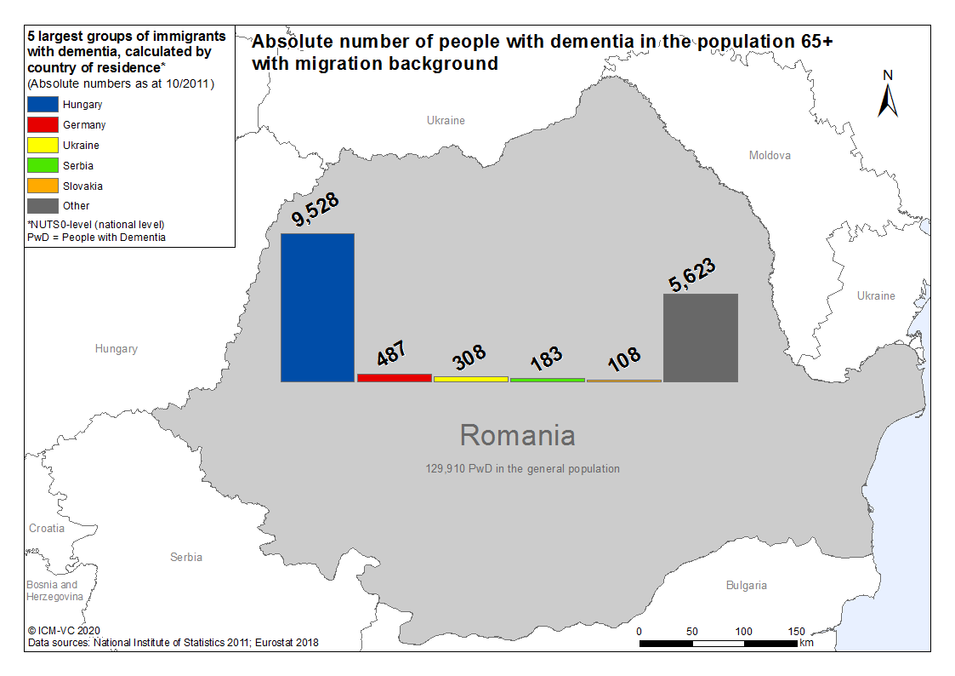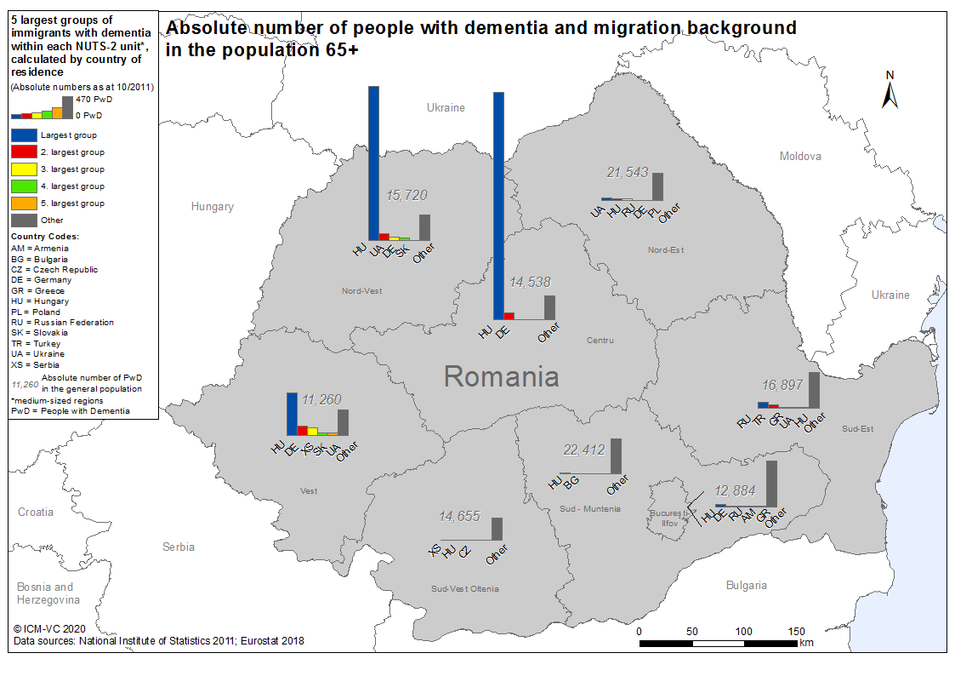EU-Atlas: Dementia & Migration
| Largest group | 2. largest group | 3. largest group | 4. largest group | 5. largest group | |
| Absolute numbers | |||||
| PwMD per 100,000 inhabitants 65+ |
| Absolute numbers | PwMD per 100,000 inhabitants 65+ | |
| Largest group | ||
| 2. largest group | ||
| 3. largest group | ||
| 4. largest group | ||
| 5. largest group |
| Prevalence per 100,000 inhabitants 65+*, calculated by country of residence | |||
|---|---|---|---|
| high > PwMD |
minor > - PwMD |
||
| increased > - PwMD |
low ≤ PwMD | ||
| medium > - PwMD |
|||
| PwMD = People with a Migration background with Dementia *Bulgarien, Litauen, Malta, Polen in der Bevölkerung 60+ |
|||
| Absolute number of PwMD 65+ | |
| PwMD per 100,000 inhabitants 65+ |
Romania
Romania has been a country of emigration for more than a century1. In mid-2007, about 3.4 million people of Romania worked abroad2. In contrast, immigration to Romania is much smaller. Only because of EU accession, Romanian companies began to hire more foreign workers1. In the second half of the 1990s, immigration from Moldova increased. In 2013, people from Moldavia, Italy, Bulgaria, Spain, and Ukraine represented the largest migrant groups3. The migrant population (born abroad) more than tripled between 1990 and 2019 (135,800 to 462,600) and their proportion in the total population quadrupled (0.6 to 2.4%)4.
There are 405,900 people with a migration background aged 65 or older. Of those, approx. 16,200 are estimated to exhibit some form of dementia. Calculations show that the most affected migrant groups presumably originate from Hungary (approx. 9,500), Germany (approx. 500), Ukraine (approx. 300), Serbia (approx. 200), and Slovakia (approx. 100)5.
In 2010 Romania has published a ‘Diagnosis and Treatment Guide for Dementia’. This document covers various topics pertaining to dementia such as diagnosis, drug treatment, risk factors, assessment of psychiatric and behavioural symptoms, and non-drug treatment of psychiatric and behavioural symptoms. The issue of migration is not addressed6.
According to an expert, the topic of dementia and migration is relatively unimportant in Romania. The healthcare system and care providers do not treat people with a migration background with dementia and their family members as a group with specific needs. No specialised public services for people with dementia from a migration background seem to exist, neither in outpatient nor inpatient care. Also, many people from the general population have access to very few information about dementia or healthcare services in rural areas.
The proportion of professional caregivers with a migration background is low in both outpatient and inpatient care in Romania. This is particularly the case for the care of older people. Currently, culturally sensitive care is not part of the training of healthcare professionals. Furthermore, there are no opportunities at the national level for the training of professionals in intercultural care. Currently, qualified professionals equipped with high cultural sensitivity are not available.
There is no difference between information and support for family caregivers of people with a migration background with dementia and non-migrants with dementia in Romania. There seem to be no need for developing specialised services for family caregivers of PwM with dementia, as their numbers are extremely low. As a result, no specialised support services are currently available for family caregivers from the migrant population.
References
- Chindea A, Majkowska-Tomkin M, Mattila H, Pastor I: Migration in Romania: A Country Profile 2008. In. Edited by Siar S; 2008.
- Horváth I: Country Profile Romania. In. Edited by Hamburgisches WeltWirtschaftsInstitut, Bundeszentrale für politische Bildung; 2007.
- United Nations: Migration Profiles: Romania; 2013.
- International Organisation for Migration: International migrant stock as a percentage of the total population at mid-year 2019: Romania; 2019.
- National Institute of Statistics: 2011 Population and Housing Census. In. Bucharest: National Institute of Statistics 2011.
- Ministry of Health: GHID DE DIAGNOSTIC ŞI TRATAMENT ÎN DEMENŢE. In., vol. 723. Official Gazette; 2010.



![[Translate to Englisch:] Logo RBS [Translate to Englisch:] Logo RBS](/fileadmin/_processed_/9/7/csm_RBS_Logo_RGB_0e245a98a4.jpeg)